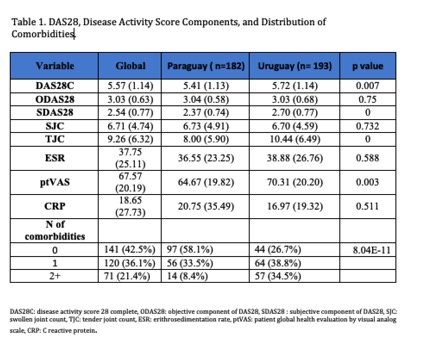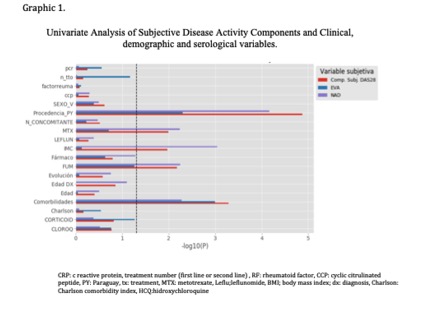Session Information
Date: Friday, November 6, 2020
Title: RA – Diagnosis, Manifestations, & Outcomes Poster I: Multimorbidity
Session Type: Poster Session A
Session Time: 9:00AM-11:00AM
Background/Purpose: Disease activity scores (DAS) are used as tools to assess persistent inflammation and need for therapeutic escalation in patients with Rheumatoid arthritis (RA). One of the most commonly used disease activity scores is DAS28, which is composed of subjective and objective variables. The subjective component is derived from the patient evaluation of global health by visual analog scale (ptVAS) and the number of tender joints (TJC). Previous studies have reported the impact of comorbidities like fibromyalgia, and depression on TJC ,ptVAS, and DAS, but less is known of how non-pain related comorbidities impact DAS..
Methods: A retrospective, observational study was conducted. Patient data was abstracted from BIOBADAGUAY registry, which prospectively collects data for rheumatologic patients undergoing biologic therapy in Paraguay and Uruguay. Entries for adult patients with RA and complete data for DAS28/TJC/ptVAS scores were used. The DAS28 formula was separated into an objective component (0.28√SJC+ 0.70 ln ESR, called oDAS28) and a subjective component (0,56√TJC + 0,√014 ptVAS, called sDAS28).Descriptive analysis of DAS28, sDAS28, oDAS28 and their individual components, as well as for reported Charlson index comorbidities was done for both populations. Patients were grouped as having 0, 1 or 2+ concomitant comorbidities besides RA. Linear regression analysis was performed to see the impact of different clinical, demographic and serologic variables on the sDAS28 and on ptVAS and TJC independently. Multivariate analysis was used to confirm associations using variables that had reached a p< 0,01 in the univariate analysis.
Results: Significant differences in DAS28 scores were noticed. Patients from Uruguay had significantly higher mean DAS28 scores than Paraguayan patients (5.72 vs. 5.41, p 0.007 respectively), despite having no difference in mean SJC, ESR, or CRP. The difference in DAS28 scores between Uruguay and Paraguay were secondary to differences in the mean ptVAS (70 mm vs. 64 mm respectively, p 0.003) and the TJC (10.4 vs. 8.0 respectively, p 0.00001). Significant differences were also noted in the distribution of number of reported concomitant comorbidities. Paraguayan patients reported a higher number of patients with no concomitant comorbidities (58.1% for Paraguay vs. 26.7% in Uruguay) and a lower number of patients with 2 + comorbidities (8.4 % for Paraguay vs. 34.5% in Uruguay). Linear regression analysis revealed that, despite both TJC and ptVAS being associated with the number of comorbidities, the impact of ptVAS on the sDAS28 was greater. Multivariate analysis confirmed the association of ptVAS with number of comorbidities ( p 0.046) , but not for TJC.
Conclusion: The number of Charlson index concomitant comorbidities in Latin-American RA patient can impact their perception of global health and therefore their final DAS28 score. Evaluation of these patients should be personalized. Decisions on therapeutic escalation should take patient characteristics into account and not based solely on DAS28 scores.
To cite this abstract in AMA style:
Zanotti-Cavazzoni M, Avila G. The Number of Associated Comorbidities Can Impact Disease Activity Scores Independently from Objective Measures of Inflammation in Patients with Rheumatoid Arthritis [abstract]. Arthritis Rheumatol. 2020; 72 (suppl 10). https://acrabstracts.org/abstract/the-number-of-associated-comorbidities-can-impact-disease-activity-scores-independently-from-objective-measures-of-inflammation-in-patients-with-rheumatoid-arthritis/. Accessed .« Back to ACR Convergence 2020
ACR Meeting Abstracts - https://acrabstracts.org/abstract/the-number-of-associated-comorbidities-can-impact-disease-activity-scores-independently-from-objective-measures-of-inflammation-in-patients-with-rheumatoid-arthritis/



